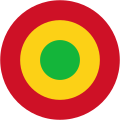 | |
| Use | National flag and ensign |
|---|---|
| Proportion | 2:3 |
| Adopted | 4 April 1959 |
| Design | A vertical tricolour of green, gold, and red |

The national flag of Mali is a vertical tricolour of green, gold, and red, [1] the pan-African colours. The flag of Mali is almost identical to the flag of Guinea, with the exception that the colours are in reverse order.











